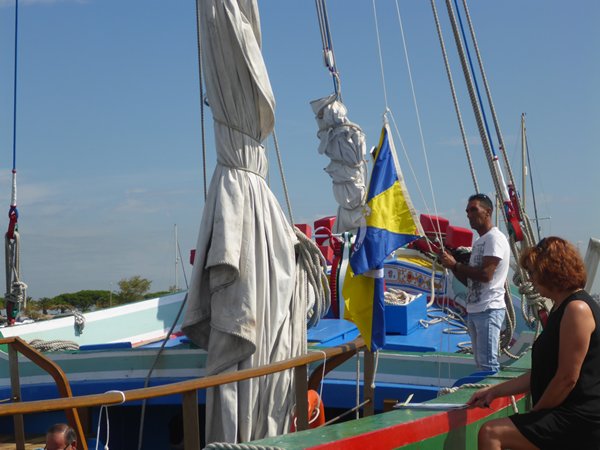Curlews call in Seixal
08 Sep 2015
38:38.9N 09:06 W
This peaceful backwater had been recommended to us as it was a short 20 minute ferry ride from the centre of Lisbon’s shoreline and we could either anchor free of charge or use a mooring for 8.30 Euros per night. As we approached the narrow entrance it became clear a railway bridge had once spanned the estuary. The passage was to the right of the central bridge support. A modern ferry was tied up inside and as I didn’t see it move for a long while I became suspicious of the advice we had had about it being a regular service. The ferry was in fact out of service and the ferry dock proper was outside the inlet. Silly me.
We tried anchoring but neither of us were happy as the scope of our anchor would give us a wider diameter than the mooring buoys that the other yachts were tied to, risking us touching our neighbour on the swing of the tide. So we picked up one of them, sat back in the cockpit, and had a welcome beer.
We motored ashore to find Carla still in the tourist office just before 7.00pm. In good English, she confirmed everything positive about Seixal, furnished us with timetables and recommended the big music festival that was underway at the far end of the lagoon. She was off there herself, but would be back in the office at 9.00am. the next day, a Sunday, so we could show her our papers then as we had left them aboard.
We spent the cool of the evening exploring old Seixal. A ribbon of cobbled streets contained some fine houses with wrought iron balconies, many now in ruins and supported by their inhabited neighbours, testiment to a wealthier past. The tree-lined square had numerous bars and restaurants but the place was quiet as all the shops had shut for the night. We sat in the shade as the light faded and enjoyed a beer. The waiter invited us to remain for a meal as a local group were going to entertain with songs, but we hadn’t brought a torch so felt we needed to motor back.
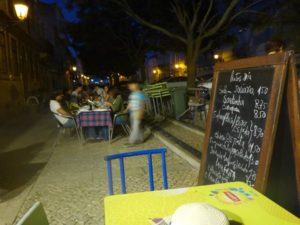
Behind the old shore level town, new Seixal comprises attractive modern apartment blocks built on sandstone cliffs, making this a dormitory town for Lisbon. What a lovely contrast, employment in the metropolis while living in this tranquil backwater. The ferry commute reminded me of mine to and from Lymington, where Emily and I lived, to Yarmouth, when I used to teach in Freshwater on the Isle of Wight until we moved there to live in Tennyson Road. The lagoon is so like the Western Yar at Yarmouth with its evidence of past industry in the form of tidemills; pounding, sawing, milling and grinding products of commercial value to be sent by train to trading and export centres. The watery cry of curlews as the tide turned and revealed fresh seafood for them completed the comparison for me.
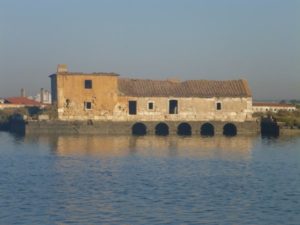
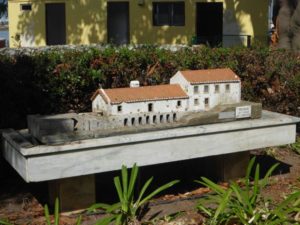
6th September, Lisbon revisited.
Back in Time.
Two black swans together sailed serenely across the lake, watched by a mature woman of indeterminate age who, having finished her lunch was chatting to the young waiter while he processed her card. She gathered her handbag and small, wheeled case and slowly, for it was a very hot day, made her way into the Edward VII gardens that swept in manicured precision of clipped hedges and razored grass downhill towards the centre of Lisbon. The wide, polished granite paths that bordered the greenery were shaded with trees and park benches allowed rest and conversation. Since there were a few hours to kill before the Youth Hostel opened its doors to the travel weary, the lady sat down, opened her book and lost herself in the story behind its pages.
The following morning, having met the five other female occupants of her room, including a banker from Madrid who was fluent in English, feeling rested and released from the burden of her case now safe in a locker, our lady set out for a day of exploration. Riding on open top buses, listening to English commentary through headphones she soaked up the architecture, history, modern day habits and atmosphere of contemporary Lisbon.
Down in the part of Lisbon rebuilt by the Marquis do Pombal after the earthquake of 1755 our lady wandered around the vast Commercial Square admiring its elegance and style but thinking ‘Oh for some shade and soft greenery’. Through the grand and mighty Arch of Rua Augusta a space was found at one of the many tables running down this pedestrian street, all shady under umbrellas. The waiters were friendly of course and warned her to keep her bag close. An armed member of the Guardia National Republic was patrolling infront of the shops to discourage pickpockets. With time to kill she lingered over her lunch before wandering up the attractive street and photographing bottles of port in a shop window, some over a hundred years old and displaying hefty price tags.
The next day Sintra and Cabo de Roca occupied her and she loved the exciting and different countryside as her coach sped past. High above the Atlantic the wind made her hair fly while she photographed the coastline and arid plants. On the way back the coach stopped at Cascais for refreshments and some fresh sea air.
On her final day in Lisbon she again had the company of her case. ‘Thank goodness for wheels’, she thought as it lumbered along obediently behind her. Gardens were on her agenda. One at the university where an open air theatre provided a welcome sit for a while. Another enclosed entirely with netting to keep in the special birds and butterflies. Then downwards towards the port she walked, as she would soon be meeting her ship, the sail training brig Stavros Niarchos, to fulfil her role as Watch Leader on the cruise back to St Nazaire down river from Nantes in France.
A quick lunch in Rua Augusta once more, then a little rest in the nearby cool, dark church before the steep ascent to Castelo de Sao Jorge on top of the hill. A kind kiosk attendant agreed to mind her case while she looked around the precipitous battlements and fascinating museum. The latter conjured up how life must have been in times past and how the views across the city to the river Tagus and mountains beyond have changed with human development spreading all the while. Beneath her the lady watched her ship arrive and life moved on.
Not too many years later the lady returned and while walking in the shade of the trees at the castle hand in hand with her husband, reflected with delight,
“I never would have thought last time that I would return with you dear Rob.”
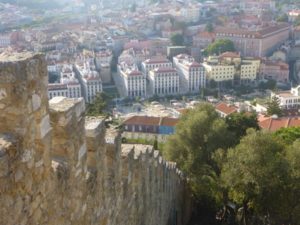
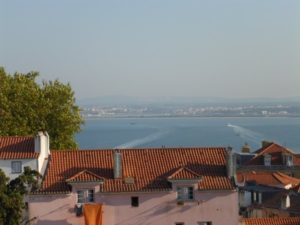
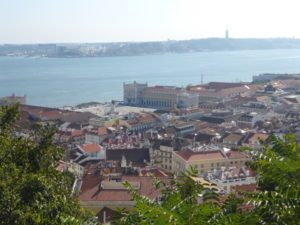
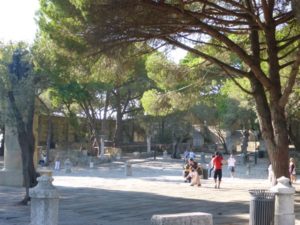
This time we made it to the Lisbon 1998 Expo area to see this 100 hectare area, now a well-established part of Lisbon life. At the Belem area on the banks of the river Tagus (Tejo) the rebuilt Torre de Belem (Bethlehem) once stood mid-river to defend the city, but silting of the north shore means long queues of tourists have only to cross just a short wooden bridge from the shore to gain entry.
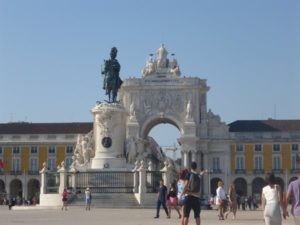
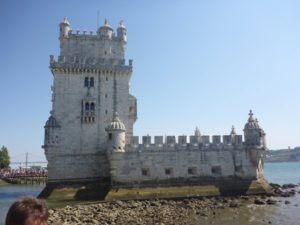
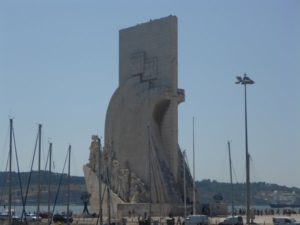
It was fun to show Rob the places I had visited, many from the top of our bus, including the Youth Hostel and I can report one vast improvement. There are now two escalators to take one to the Castle of St George!
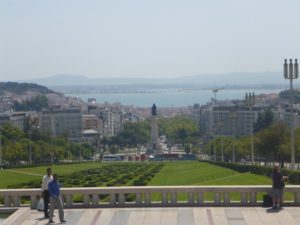
Tender troubles.
When we returned to Seixal after our first day in Lisbon we found the other side of the tender had blown a seam in the heat (it had been around 30’ and we hadn’t released any air before leaving it). The marineiro had secured the motor with rope to a rail on the concrete pier, otherwise it may well have sunk. Also he had effected a repair with duck-tape. So in the dark we pumped it up and made our way back to Zoonie while I pressed my hand firmly over the leak.
Motor and dinghy safely on board we pondered the need to replace it while we supped some Jamesons. It appeared to have failed at exactly the opposite spot to the other leak, ie at the highest point of the tender. Hot air rises we thought so maybe those are the weakest points.
The next morning Rob patched the leak while I tried to get the attention of the marinero to give us a lift ashore. No answer on the VHF or phone number we had and neither the local police (they didn’t appear to be too busy!) nor the local council lady spoke any English. So guess what, out with the inflatable canoe, now referred to as ‘Plan B’ and a gentle paddle ashore to catch the ferry for our last day in Lisbon.
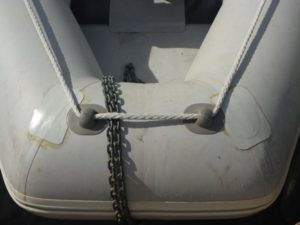
We thanked the marinero for saving the engine and patching the leak and through tactful investigation I discovered his handheld VHF was turned off and although my mobile number had come through on his work mobile and it was in his pocket, he hadn’t answered it. Never mind, we solved the problem independently.
Its just as well we did because the marinero works office hours to 7.00pm and when we got back to the ferry terminal in Lisbon we were locked out. We all waited patiently and will never know whether it was a security issue, strike or something to do with the man Rob saw being arrested, but it was 8.30pm and dark when we got back. We lifted the canoe onto the pontoon to replace the air we had let out and then under a starlit sky, with the town street lights showing up Zoonie’s white hull a treat, we had a lovely night-time paddle home.
Au Revoir Seixal and I hope we will see you again one day.
The day dawned bright and peaceful with curlews calling and commuters ‘crawling’ to their ferry while cockle fishers, waist high in water, shoved their rakes and nets back and forth. The ground floor of the nearest tide mill was home to cockle fishing squatters and their tail wagging black dog. The old feller had slept outside under a tree but as the sun rose and the squatters prepared to leave on a scooter they locked him inside in the dark shade to keep him safe.
Ashore we thanked Carlos for saving our motor and went to pay for the extra night we had spent languishing on the mooring in this darling of a place. But the marina lady spoke by phone to Carlos and decided we needn’t pay more, so the money went on two coffees and pastis de nata. The centre of old Seixal is child oriented, the very young playing in a secure park under watchful eyes while their older friends, in school uniform, await their trip on the local sailing barge.
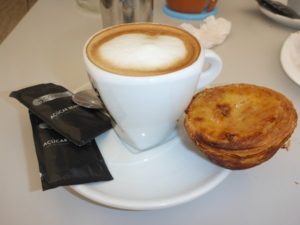
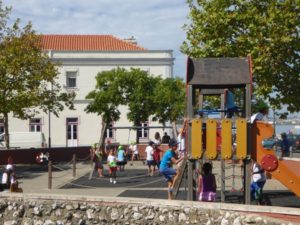
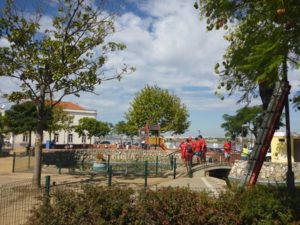
Back aboard we awaited the rising tide to cease and turn so we could float down the Tagus on the ebb. Temporarily the issue of the tender, to replace or not to replace it, rested since Rob had effected another good repair and this morning it held up just fine. I had a feeling the debate was not yet over though. A diver was underwater beside us, revealing himself with rhythmic bubbles, as he gathered clams from the rocks beneath 20 feet of water.
A cruise ship, tug, passenger ferry and replica sailing ship all accompanied us down the mighty Tagus and another view of all the shoreside attractions and history was very welcome. We anchored just outside Cascais Marina (the most expensive in Europe) not needing any of its facilities and had a comfortable night.
10th September Sizzling to another favourite place from last year, Sines (Cinch).
We had thought of stopping at Sesimbra to break up the 50 mile trip but as Zoonie was sailing so well in a fine wind we pressed on. We made the identical decision last year when returning home from the Azores. Having left Dartmouth we intended to stop the night at Portland but the steady off the beam wind and following sea convinced us to continue until we let go the anchor and chain in Studland Bay just before midnight! Magic.
This time we had the sea directly behind and the Atlantic rollers were sizeable. Standing amidships at the helm, for the slow reacting autopilot could cause Zoonie to run amok in these conditions, I felt her stern lift as a wave took her. The water pressure on her hull warned me what alteration in course if any she needed. As the surging wave moved forward Zoonie rose and gained speed. The speedo reads 6.4 – 7.1 – 8.3 knots. Her bow is steady at right angles to the wave when from behind her beam all around is white breaking, boiling water hissing and sizzling. She wore her white lace skirt well at 8.4 – 8.5 knots. Goodness, how much faster can she go? Then the exhausted wave sinks down and so does Zoonie as she sighs with regret and drops back to 7.1 knots.
There was still an hour of daylight left as we anchored in the inner harbour at Sines, just outside the marina which looked sadly empty. I felt a little guilty, avoiding their dues and was relieved when Rob said they do charge for anchoring and using the marina facilities. Fair enough. At least they allow anchoring unlike greedy Figuera. The marinero was ready to help us in but was good natured about our pointing to the beach where the holding was good over sand. As we rested aboard the clicking fish we remembered from last year set to work cleaning up the hull.
